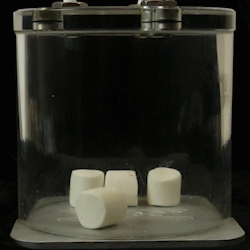Gas molecules, even in the air we breathe, like their space. They bounce off barriers, other objects and each other to fill a space as evenly as they can. So what happens when they are exposed to a change in pressure?

In this demonstration we see the effects of vacuum pressure, differential pressure and bi-directional pressure. Four marshmallows are sealed inside a bell jar with an atmospheric pressure of about 14.5 psi. This pressure is created by millions of air particles bouncing off every surface inside the jar, including the surface of the marshmallows. The air outside the marshmallows and the entrained air within the marshmallows is at the same pressure and an equilibrium exists.
In this equilibrium the marshmallows hold their original cylindrical shape. Inside they are porous with tiny air pockets that give them the light, airy texture that make them a favorite snack and hot cocoa topping.
When a vacuum is applied to the bell jar, the gas molecules that were bouncing off the walls and the marshmallows rush out of the jar toward the lower pressure created by the vacuum pump. As the gas molecules vacate the bell jar they are no longer pressing down on the marshmallows, and the air inside the flexible structure of the marshmallows is no longer in equilibrium with the air outside. In this transitional state, a pressure gradient exists. There is now a relatively greater force inside, where there are still air particles, versus outside the marshmallow. The difference in pressure causes the air inside to expand and to partially escape from the structure of the marshmallow. This causes the marshmallows to expand in size.
The difference between the pressure inside the marshmallow and outside the marshmallow is called differential pressure. Imagine if the marshmallows represented a control room in an industrial plant, or the cabin of an airplane. These conditions would be uncomfortable and unsafe for humans, which is why it's important to measure differential pressure.
Once the vacuum reaches a plateau, equilibrium is again achieved between the remaining air in the marshmallow and the partial vacuum in the bell jar. At this point, they have peaked in size. The vacuum pump is then turned off and a valve is opened to allow atmospheric pressure back into the bell jar. Many of the air molecules that were entrained in the marshmallow have now escaped through its porous structure, but cannot retake their place inside the marshmallow. We witness the marshmallows "deflate” to a smaller size than their original form, due to the atmospheric pressure introduced to the jar.
As the marshmallows stabilize with their new size and shape, equilibrium once again exists between the air outside the marshmallows and the remaining air within the marshmallows.
What are your favorite ways to demonstrate and experiment with pressure? Let us know in the comments!
Related Reading:


